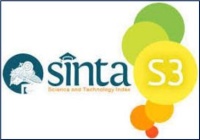Evaluating the Efficacy of Topical Moringa Oleifera and Aloe Vera Extracts in Accelerating Second-Degree Burn Wound Healing
Abstract
Burn injuries are a global health issue, particularly second-degree burns, which damage both the epidermis and dermis. This has led to the exploration of natural treatments like Moringa oleifera (moringa) and Aloe vera for their potential in wound healing, pain relief, and infection prevention. This study aimed to evaluate the efficacy of a topical formulation containing extracts of Moringa oleifera and Aloe vera in accelerating the healing of second-degree burn wounds. This study employed a true experimental design with Sprague Dawley rats, divided into four groups (control positive, control negative, and two treatment groups). The experiment utilized topical formulations combining different concentrations of Moringa oleifera and Aloe vera extracts. The wound healing process was assessed through macroscopic observation and histopathological analysis, measuring the diameter of the burn wounds at different time intervals. Results showed that formulations containing Moringa oleifera and Aloe vera extracts significantly improved wound healing compared to the control group. The formulation with a 50:50 ratio of Moringa oleifera and Aloe verademonstrated the highest efficacy, reducing wound size and promoting fibroblast proliferation and vascularization. This study confirms the potential of a topical combination of Moringa oleifera and Aloe vera extracts in accelerating the healing of second-degree burns.
Keywords
Full Text:
PDFReferences
Al-Ghanayem, A. A., Alhussaini, M. S., Asad, M., & Joseph, B. (2022). Moringa oleifera Leaf Extract Promotes Healing of Infected Wounds in Diabetic Rats: Evidence of Antimicrobial, Antioxidant and Proliferative Properties. Pharmaceuticals (Basel, Switzerland), 15(5). https://doi.org/10.3390/ph15050528
Alajmi, M. M., Aldosari, K. H., & Al-Ghamdi, S. (2021). Clinical, epidemiological, and management aspects of burn injuries in Saudi Arabia – A cross-sectional study. Saudi Journal of Biological Sciences, 28(8), 4342–4347. https://doi.org/10.1016/j.sjbs.2021.04.021
Almehayawi, M. S., Almuhayawi, M. S., El-Fadl, S. R. A., Nagshabandi, M. K., Tarabulsi, M. K., Selim, S., Alruwaili, Y. S., Mostafa, E. M., Jaouni, S. K. Al, & Abdelghany, T. M. (2024). Evaluating the Anti-yeast, Anti-diabetic, Wound Healing Activities of Moringa oleifera Extracted at Different Conditions of Pressure via Supercritical Fluid Extraction. BioResources, 19(3), 5961–5977. https://doi.org/DOI: 10.15376/biores.19.3.5961-5977
Avsar, U., Halici, Z., Akpinar, E., Yayla, M., Avsar, U., Un, H., Hasan Tarik, A., & Bayraktutan, Z. (2016). The Effects of Argan Oil in Second-degree Burn Wound Healing in Rats. Ostomy Wound Management, 62(3), 26–34. https://www.researchgate.net/profile/Muhammed-Yayla-2/publication/298420365_The_Effects_of_Argan_Oil_in_Second-degree_Burn_Wound_Healing_in_Rats/links/5df87d7292851c8364831c87/The-Effects-of-Argan-Oil-in-Second-degree-Burn-Wound-Healing-in-Rats.pdf
Cialdai, F., Risaliti, C., & Monici, M. (2022). Role of fibroblasts in wound healing and tissue remodeling on Earth and in space. Frontiers in Bioengineering and Biotechnology, 10, 958381. https://doi.org/10.3389/fbioe.2022.958381
Georgescu, M., Marinas, O., Popa, M., Stan, T., Lazar, V., Bertesteanu, S. V., & Chifiriuc, M. C. (2016). Natural Compounds for Wound Healing. In Worldwide Wound Healing - Innovation in Natural and Conventional Methods. https://doi.org/10.5772/65652
Haghani, F., Arabnezhad, M. R., Mohammadi, S., & Ghaffarian-Bahraman, A. (2022). Aloe vera and Streptozotocin-Induced Diabetes Mellitus. Revista Brasileira de Farmacognosia, 32(2), 174–187. https://doi.org/10.1007/s43450-022-00231-3
Hekmatpou, D., Mehrabi, F., Rahzani, K., & Aminiyan, A. (2019). The Effect of Aloe Vera Clinical Trials on Prevention and Healing of Skin Wound: A Systematic Review. Iranian Journal of Medical Sciences, 44(1), 1–9.
Jindal, D. K., Sah, P., Bisht, D., Lalhlenmawia, H., Kumar, D., & Kumar, D. (2021). Role of Medicinal Plants in Pulmonary Hypertension. In Medicinal Plants for Lung Diseases: A Pharmacological and Immunological Perspective (pp. 303–316). Springer Nature. https://doi.org/10.1007/978-981-33-6850-7_13
Khan, M., Rehan, M., Ali, U., Trauma, T. I.-J. B., & 2018, undefined. (2018). Epidemiology of burns: A decade experience. Academia.Edu, 3(2), 1042. https://www.academia.edu/download/92926379/burns-3-1042.pdf
Mastuti, N. L. P. H., Etika, R., Utomo, M. T., Angelika, D., & Handayani, K. D. (2023). Silver sulfadiazine as the topical treatment for giant omphalocele: a case report. Bali Medical Journal, 12(1), 59–63. https://doi.org/10.15562/bmj.v12i1.3620
Mawaddani, N., Sutiyanti, E., Widyananda, M. H., Kharisma, V. D., Turista, D. D. R., Tamam, M. B., Jakhmola, V., Syamsurizal, Fajri, B. R., Ghifari, M. R., Albari, M. T., Ghifari, M. A., Lubis, A. P., Novaliendry, D., Putri, D. H., Fitri, F., Sari, D. P., Nugraha, A. P., Ansori, A. N. M., … Zainul, R. (2022). In Silico Study of Entry Inhibitor from Moringa oleifera Bioactive Compounds against SARS-CoV-2 Infection. Pharmacognosy Journal, 14(5), 565–574. https://doi.org/10.5530/pj.2022.14.137
Mohammad Shafie, N., Raja Shahriman Shah, R. N. I., Krishnan, P., Abdul Haleem, N., & Tan, T. Y. C. (2022a). Scoping Review: Evaluation of Moringa oleifera (Lam.) for Potential Wound Healing in In Vivo Studies. Molecules, 27(17). https://doi.org/10.3390/molecules27175541
Mohammad Shafie, N., Raja Shahriman Shah, R. N. I., Krishnan, P., Abdul Haleem, N., & Tan, T. Y. C. (2022b). Scoping Review: Evaluation of Moringa oleifera (Lam.) for Potential Wound Healing in In Vivo Studies. Molecules (Basel, Switzerland), 27(17). https://doi.org/10.3390/molecules27175541
Retnowati, D., Sari, R., Hendradi, E., & Septiani, S. (2021). The stability and irritability study of the chitosan-Aloe vera spray gel as wound healing. Journal of Basic and Clinical Physiology and Pharmacology, 32(4), 651–656. https://doi.org/10.1515/jbcpp-2020-0407
DOI: https://doi.org/10.33394/bioscientist.v12i2.13071
Refbacks
- There are currently no refbacks.

This work is licensed under a Creative Commons Attribution-ShareAlike 4.0 International License.

Bioscientist : Jurnal Ilmiah Biologi is licensed under a Creative Commons Attribution-ShareAlike 4.0 International License
Editorial Address: Pemuda Street No. 59A, Catur Building Floor I, Mataram City, West Nusa Tenggara Province, Indonesia











